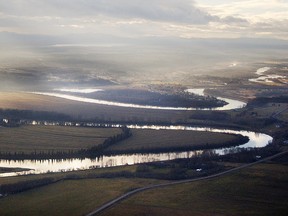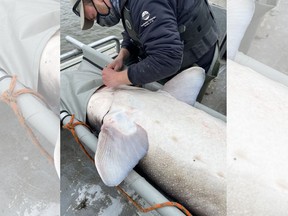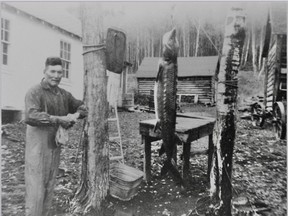
A group of B.C. First Nations are calling on Australian mining giant Rio Tinto Alcan to release more water into the Nechako River after a sudden die-off of endangered white sturgeon.
Last month, the Ministry of Land, Water and Resource Stewardship reported 11 dead adult white sturgeon had been found in the Nechako River – an unusual occurrence. White sturgeon can grow to six-metres long and live more than 100 years. They are an endangered species with between 300 to 600 remaining in the wild.
Start your day with a roundup of B.C.-focused news and opinion delivered straight to your inbox at 7 a.m., Monday to Friday.
Thanks for signing up!
A welcome email is on its way. If you don't see it, please check your junk folder.
The next issue of Sunrise presented by Vancouver Sun will soon be in your inbox.
Scientists said the fish had not died from disease, chemical exposure or due to fishing, and had no signs of injury. The government then reached out to local First Nations.

On Thursday, the Nechako First Nations said the province, federal government and Rio Tinto Alcan needed to immediately address “continuing mismanagement of the Nechako”.
“The recent deaths of 11 endangered Nechako white sturgeon are just the latest blow to this endangered species, and together with significantly diminishing sockeye salmon populations, highlight the urgency for action,” the group said.
The Nechako River was dammed at its source on the eastern edge of the Kitimat Ranges in the early 1950s to provide power to the Alcan aluminum smelter in Kitimat that is now owned by Rio Tinto. As a result, Indigenous communities were consumed by the 230 km reservoir system west of the dam, while the original flow of the river to Prince George — where it enters the Fraser River — was reduced by two thirds.
The more water stored behind the dam the more power Rio Tinto is able to generate and use or sell, at the cost of the river downstream.
The river was once a significant breeding ground for salmon and Nechako white sturgeon and an integral part of Indigenous life.

Last October, the Saik’uz, Stellat’en and Nadleh Whut’en First Nations (the Nechako First Nations) signed a Memorandum of Understanding with the Regional District of Bulkley Nechako to create a new water flow regime for the river “that benefits all people within the watershed.”
Then in January this year a decade long legal action by the impacted First Nations to have the river flow restored was rejected by the Supreme Court of B.C.
The court ruled that while the damning of the river had caused significant and continuing harm to the river and its fisheries, the dam was built with federal and provincial government approval.
The court did rule however that the provincial and federal governments had an obligation to protect the plaintiffs’ right to fish by doing what they could to protect the remaining fishery.
The Nechako First Nations now argue that the recognition that they have a constitutional right to fish the river means the current water management regime must be renegotiated.
“The Court also found that the continuing regulation of the Nechako River is resulting in an infringement of the Nechako First Nations’ rights, which can no longer be justified in the circumstances,” the bands said.


